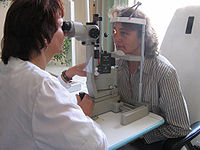
Photo from wikipedia
ABSTRACT Clinical relevance Current levels of appropriateness for primary diabetic eyecare delivered by Australian optometrists are presented along with realistic targets (benchmarks) for quality improvement. The demonstrated methods can be… Click to show full abstract
ABSTRACT Clinical relevance Current levels of appropriateness for primary diabetic eyecare delivered by Australian optometrists are presented along with realistic targets (benchmarks) for quality improvement. The demonstrated methods can be used in practice evaluation and benchmarking of other clinical practice areas and settings. Background To examine the appropriateness of diabetic eye-care delivery and establish achievable benchmarks of care (ABCs) for optometry practices in Australia. Method In a retrospective audit, clinical records of patients with type-II diabetes obtained from a randomly selected nationally representative sample of optometry practices were assessed against evidence-based clinical indicators. Appropriate care is defined as care delivered in compliance with the indicators. The ABC for each indicator was calculated as the average performance for the top 10% of optometry practices after Bayesian adjustment to account for a low number of eligible records. Results The audit of 420 randomly selected patient records from 42 practices against 12 clinical indicators showed an overall appropriateness of 69% (95% confidence interval (CI) 66%, 73%) for overall diabetic eye care. While a high level of appropriateness was identified for recall period (93%, 95% CI 85%, 100%) and referral (100%, 95% CI 38%, 100%), larger gaps existed in history taking (46%, 95% CI 44%, 52%), dilated fundus examination (80%, 95% CI 76%, 84%) and iris examination (0%, 95% CI 0%, 56%). The ABCs for 8 of 12 indicators were 100%, and the remaining three indicators had ABCs above 80%. An ABC for the iris examination indicator could not be calculated owing to the low number of eligible patient record cards. Conclusions This study demonstrated a systematic process of practice evaluation and benchmarking in optometry practices. The diabetic eye care delivered by Australian optometrists was largely appropriate; however, improvement opportunities exist for history taking and physical examination. The ABCs demonstrate that excellence in primary diabetic eye care is attainable and will serve as an important tool in future initiatives to reduce the identified evidence-to-practice gaps.
Journal Title: Clinical and Experimental Optometry
Year Published: 2022
Link to full text (if available)
Share on Social Media: Sign Up to like & get
recommendations!